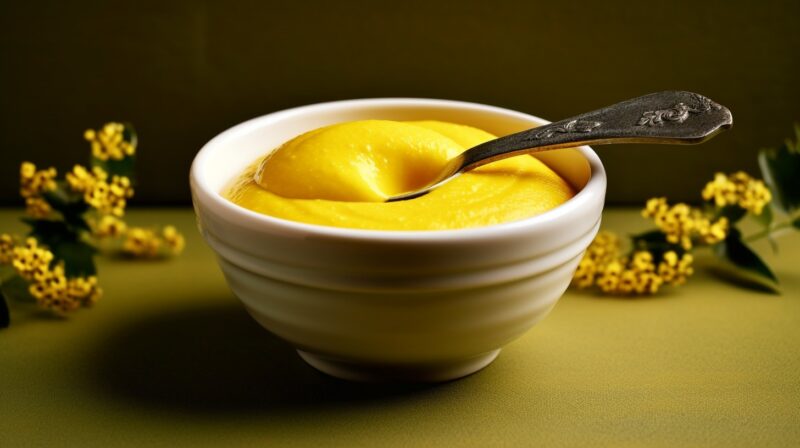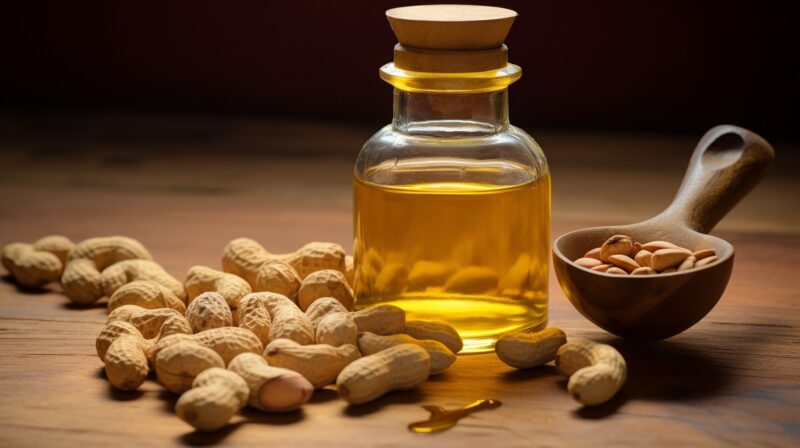
Exploring new flavors and ingredients can be such an adventure, right? Sometimes, we might want to switch things up a bit, either for health reasons, dietary choices, or simply to try something new.
Dijon mustard, with its distinct taste, is a staple in many dishes. But what if you’re looking for an alternative? Whether you’re curious about the health aspects of Dijon, embarking on a new diet, or just in the mood to experiment, I’ve got some fantastic Dijon mustard substitutes to share with you.
| Nutrient | Amount per 100g |
|---|---|
| Calories | 66 |
| Total Fat | 3.3g |
| Saturated Fat | 0.2g |
| Sodium | 813mg |
| Total Carbohydrates | 6g |
| Dietary Fiber | 3.3g |
| Sugars | 1.3g |
| Protein | 5.7g |
| Vitamin D | 0% (DV) |
| Calcium | 56mg |
| Iron | 2.1mg |
Table of Contents
Toggle1. Yellow Mustard
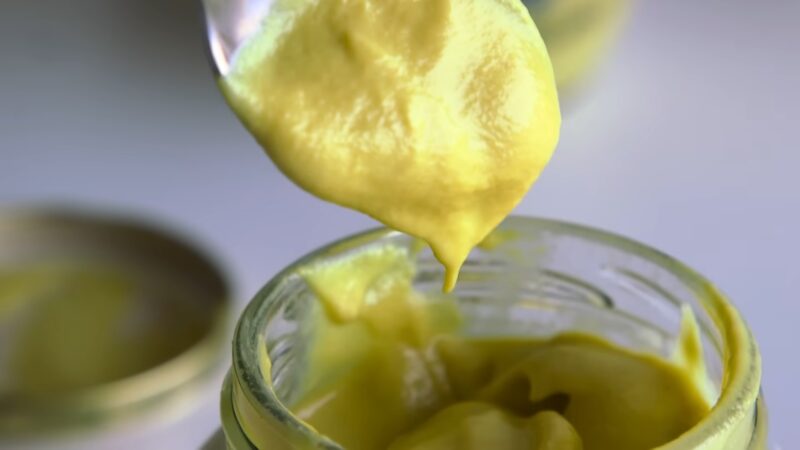
Yellow mustard, often simply called “prepared mustard,” is a staple in many households. Made from white mustard seeds, vinegar, water, and turmeric (which gives it that vibrant yellow color), it’s milder and less spicy than Dijon. Its tangy and slightly sweet flavor profile makes it versatile and a favorite for many classic dishes.
Dishes Where Yellow Mustard Shines:
- Hot Dogs & Burgers: A classic American fast food favorite, where a streak of yellow mustard adds that tangy kick in any hot dog, and it’s very important to boil them properly.
- Potato Salad: Yellow mustard gives this dish a delightful zest, complementing the creaminess of the potatoes.
- Barbecue Marinades: Mix it with some honey or brown sugar, and you’ve got a tangy-sweet marinade perfect for grilling.
- Sandwiches & Wraps: A smear of yellow mustard can elevate the taste of your deli meats and veggies.
- Deviled Eggs: A dash of yellow mustard mixed with the yolk filling gives these eggs their signature tang.
| Nutrient | Amount per 100g |
|---|---|
| Calories | 57 |
| Total Fat | 3.1g |
| Saturated Fat | 0.2g |
| Sodium | 728mg |
| Total Carbohydrates | 3.7g |
| Dietary Fiber | 2.8g |
| Sugars | 1.3g |
| Protein | 4.4g |
| Vitamin D | 0% (DV) |
| Calcium | 67mg |
| Iron | 1.9mg |
2. Honey Mustard
Honey mustard is a delightful fusion of the tangy kick of mustard and the sweet allure of honey. This combination results in a condiment that’s both creamy and zesty, making it a versatile choice for those who enjoy a balance of flavors. Its sweet undertones make it a favorite for both savory dishes and some unexpected sweet treats.
Dishes Where Yellow Mustard Shines:
- Chicken Tenders & Nuggets: Dip them in honey mustard, and every bite becomes a sweet and savory delight.
- Salad Dressings: Drizzle over mixed greens, nuts, and fruits for a refreshing and flavorful salad.
- Ham & Cheese Sandwiches: The sweetness of honey mustard complements the saltiness of ham beautifully.
- Grilled Salmon: Brush some honey mustard on salmon before grilling for a caramelized, flavorful crust.
- Pretzels & Snack Dips: Whether it’s soft pretzels or assorted veggies, honey mustard serves as a perfect dipping companion.
| Nutrient | Amount per 100g |
|---|---|
| Calories | 217 |
| Total Fat | 11.8g |
| Saturated Fat | 1.8g |
| Sodium | 570mg |
| Total Carbohydrates | 28g |
| Dietary Fiber | 0.8g |
| Sugars | 25g |
| Protein | 1.3g |
| Vitamin D | 0% (DV) |
| Calcium | 23mg |
| Iron | 0.7mg |
3. Wasabi
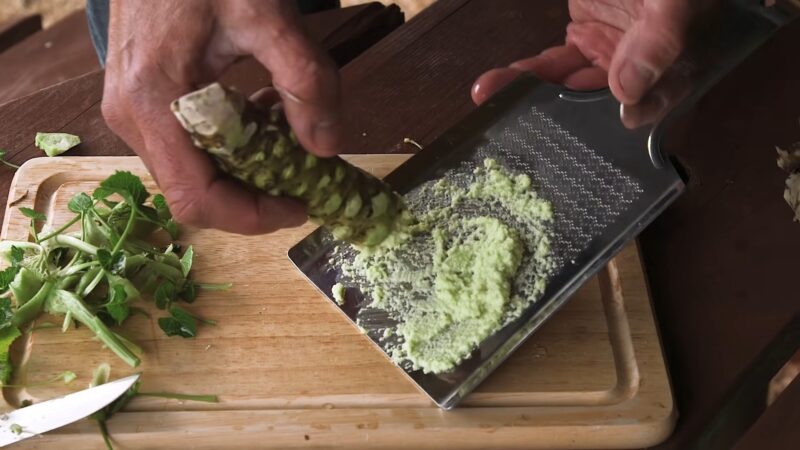
Wasabi, often referred to as “Japanese horseradish,” is a green paste with a fiery kick. Made from the grated root of the Wasabia japonica plant, its intense heat is more akin to a strong, sinus-clearing sensation rather than the lingering burn of chili peppers. While it’s a staple for sushi and sashimi, its unique flavor and heat can be harnessed in various other dishes, making it an intriguing substitute for Dijon mustard for those who dare.
Dishes Where Wasabi Shines:
- Sushi & Sashimi: A classic pairing, where a dab of wasabi adds a burst of heat to fresh fish.
- Steak: A wasabi-infused sauce or butter can add an unexpected kick to your grilled or pan-seared steak.
- Mashed Potatoes: Mix in some wasabi for a spicy twist on this comforting side dish.
- Noodle Bowls: Drizzle a wasabi-soy sauce over your favorite noodle dish for an added layer of flavor.
- Cocktails: Believe it or not, a hint of wasabi in a Bloody Mary or martini can elevate the drink to a whole new level.
| Nutrient | Amount per 100g |
|---|---|
| Calories | 71 |
| Total Fat | 0.6g |
| Saturated Fat | 0.1g |
| Sodium | 17mg |
| Total Carbohydrates | 17g |
| Dietary Fiber | 6g |
| Sugars | 9g |
| Protein | 4.8g |
| Vitamin D | 0% (DV) |
| Calcium | 128mg |
| Iron | 1.0mg |
4. Egg whites
Egg whites are often overlooked in the realm of condiments and sauces. However, their unique protein structure allows them to act as a binding and thickening agent when cooked. While they don’t impart the sharp flavor of Dijon mustard, they can provide a similar texture and consistency in recipes, especially when the primary goal is to achieve a certain mouthfeel or body in a dish.
Dishes Where Egg whites Shine:
- Meringues: Whipped to stiff peaks, egg whites are the star in these light and airy desserts.
- Soufflés: Egg whites give these dishes their signature rise and fluffy texture.
- Cocktails: In classics like the Pisco Sour or Whiskey Sour, shaken egg whites provide a frothy top layer.
- Angel Food Cake: This sponge cake relies on whipped egg whites for its delicate structure.
- Protein Smoothies: For those looking to boost protein intake, adding egg whites to smoothies can be a great choice.
| Nutrient | Amount per 100g |
|---|---|
| Calories | 52 |
| Total Fat | 0.2g |
| Saturated Fat | 0g |
| Sodium | 166mg |
| Total Carbohydrates | 0.7g |
| Dietary Fiber | 0g |
| Sugars | 0.7g |
| Protein | 11g |
| Vitamin D | 0% (DV) |
| Calcium | 6mg |
| Iron | 0.1mg |
5. Spicy Brown Mustard
Spicy Brown Mustard, sometimes known as deli mustard, is made from brown mustard seeds that have been coarsely ground, giving it a grittier texture than Dijon or Yellow Mustard. Its flavor profile is deep and robust, with a noticeable heat that lingers. This mustard is a favorite for those who appreciate a bolder taste, making it a versatile addition to various dishes.
Dishes Where Spicy Brown Mustard, Shines:
- Deli Sandwiches: Its robust flavor pairs perfectly with hearty meats like pastrami or roast beef.
- Bratwurst & Sausages: A smear of spicy brown mustard complements the rich flavors of grilled or baked sausages.
- Vinaigrettes: Mix it with some olive oil, vinegar, and seasonings for a spicy salad dressing.
- Meat Marinades: Its bold flavor can enhance the taste of meats, especially pork and beef.
- Stews & Braises: A spoonful can add depth and a spicy kick to slow-cooked dishes.
| Nutrient | Amount per 100g |
|---|---|
| Calories | 66 |
| Total Fat | 3.6g |
| Saturated Fat | 0.2g |
| Sodium | 787mg |
| Total Carbohydrates | 5g |
| Dietary Fiber | 3.4g |
| Sugars | 1.2g |
| Protein | 4.8g |
| Vitamin D | 0% (DV) |
| Calcium | 59mg |
| Iron | 2.0mg |
6. Mayonnaise
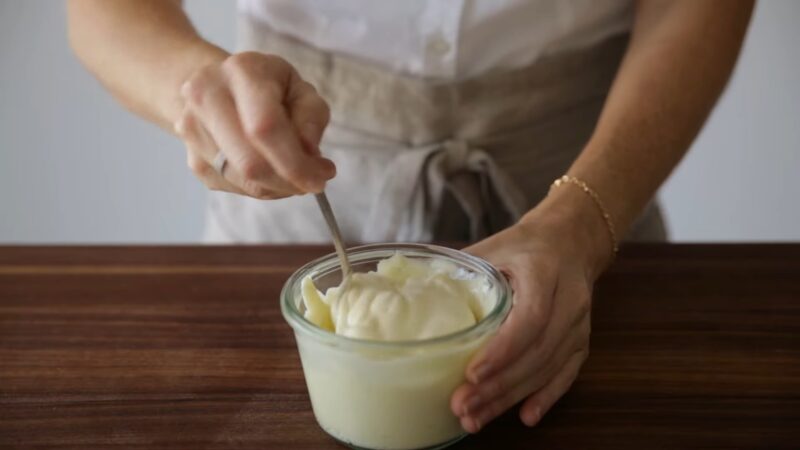
Mayonnaise, often simply called “mayo,” is a creamy, white condiment made primarily from oil, egg yolks, and vinegar or lemon juice. Its rich and velvety texture, combined with its mild flavor, makes it a versatile ingredient in both cooking and baking. While it might be a polarizing condiment for some, there’s no denying its pivotal role in countless dishes worldwide.
Dishes Where Mayonnaise Shines:
- Tuna & Chicken Salad: Mix with some diced veggies and protein for a creamy, cold salad.
- Coleslaw: The base for many coleslaw dressings, mayo adds creaminess to shredded cabbage and carrots.
- Dips & Aioli: Combine with herbs, spices, or other condiments to create flavorful dips or aioli for fries and veggies.
- Egg Salad: Hard-boiled eggs, mayo, and seasonings come together for this classic sandwich filling.
- Baked Goods: Believe it or not, mayo can be used in cakes and other baked goods to add moisture.
| Nutrient | Amount per 100g |
|---|---|
| Calories | 680 |
| Total Fat | 75g |
| Saturated Fat | 11.6g |
| Sodium | 800mg |
| Total Carbohydrates | 0.6g |
| Dietary Fiber | 0g |
| Sugars | 0.6g |
| Protein | 0.9g |
| Vitamin D | 0% (DV) |
| Calcium | 10mg |
| Iron | 0.4mg |
7. Whole Grain Mustard
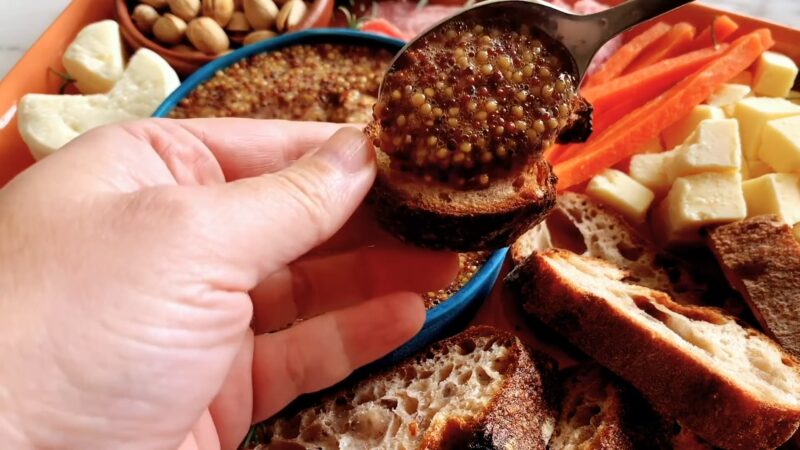
Whole grain mustard, as the name suggests, is made with whole mustard seeds. This gives the condiment a distinct, coarse texture that’s bursting with little bursts of flavor with every bite. The seeds are typically soaked in vinegar, wine, or beer, which imparts a tangy flavor that complements the natural spiciness of the seeds. Its rustic appearance and layered taste make it a favorite for those who appreciate both texture and depth in their dishes.
Dishes Where Whole Grain Mustard Excels:
- Charcuterie Boards: Its textured consistency pairs wonderfully with cured meats and cheeses.
- Roast Meats: Use it as a rub or glaze for meats like pork, beef, or chicken to add a flavorful crust.
- Vinaigrettes: The seeds add a delightful crunch to salad dressings.
- Sandwiches & Wraps: A spread of whole grain mustard can elevate a simple sandwich to gourmet levels.
- Sauces & Gravies: Mix into cream or broth-based sauces for an added layer of flavor and texture.
| Nutrient | Amount per 100g |
|---|---|
| Calories | 100 |
| Total Fat | 6g |
| Saturated Fat | 0.3g |
| Sodium | 700mg |
| Total Carbohydrates | 6g |
| Dietary Fiber | 3.5g |
| Sugars | 2g |
| Protein | 5g |
| Vitamin D | 0% (DV) |
| Calcium | 70mg |
| Iron | 2.5mg |
8. Worcestershire Sauce
Worcestershire Sauce is a complex, fermented condiment that originated in Worcester, England. It’s a dark, liquid sauce made from a blend of ingredients like vinegar, molasses, anchovies, garlic, tamarind, and various seasonings. Its flavor profile is a unique combination of sweet, salty, tangy, and umami, making it a versatile addition to a wide range of dishes. Its depth and richness can elevate the taste of many recipes, adding layers of flavor with just a few dashes.
Dishes Where Worcestershire Sauce Shines:
- Bloody Mary: This classic cocktail benefits from the tangy kick of Worcestershire Sauce.
- Steak Marinades: Enhances the meaty flavor and adds a savory depth to beef.
- Chili & Stews: A few dashes can add complexity to these hearty dishes.
- Caesar Salad Dressing: An essential ingredient that gives the dressing its signature tang.
- Shepherd’s Pie: Mixed into the meat filling, it provides a rich, savory undertone.
| Nutrient | Amount per 100g |
|---|---|
| Calories | 77 |
| Total Fat | 0.9g |
| Saturated Fat | 0.2g |
| Sodium | 704mg |
| Total Carbohydrates | 18g |
| Dietary Fiber | 0g |
| Sugars | 9g |
| Protein | 0.8g |
| Vitamin D | 0% (DV) |
| Calcium | 73mg |
| Iron | 3.3mg |
9. Beer Mustard
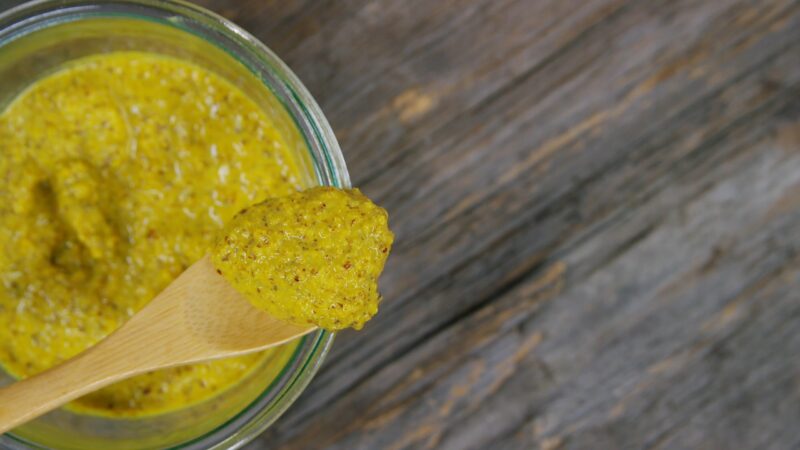
Beer Mustard combines the tangy and spicy notes of mustard with the rich, malty flavors of beer. This fusion results in a condiment that’s both robust and aromatic. Depending on the type of beer used, the mustard can have varying notes ranging from sweet and caramel-like to bitter and hoppy. It’s a gourmet choice for those looking to add a unique twist to traditional mustard flavors.
Dishes Where Beer Mustard Excels:
- Bratwurst & Sausages: The beer-infused flavor complements the meatiness of these grilled favorites.
- Pretzel Dip: Pair with soft pretzels for a savory treat with a hint of malt.
- Sandwich Spread: Elevate your deli sandwiches with a smear of beer mustard for added depth.
- Salad Dressings: Mix with olive oil and vinegar for a zesty vinaigrette with a malty undertone.
- Glazes for Roasted Meats: Brush onto pork, chicken, or beef for a caramelized, flavorful crust.
| Nutrient | Amount per 100g |
|---|---|
| Calories | 120 |
| Total Fat | 6g |
| Saturated Fat | 0.5g |
| Sodium | 650mg |
| Total Carbohydrates | 10g |
| Dietary Fiber | 4g |
| Sugars | 4g |
| Protein | 5g |
| Vitamin D | 0% (DV) |
| Calcium | 60mg |
| Iron | 2mg |
10. Horseradish Sauce

Horseradish Sauce is made from the grated root of the horseradish plant, combined with vinegar, and often cream or mayonnaise to mellow out its intense heat. The result is a sauce that packs a sharp, peppery punch.
Its fiery nature is not like that of chilies; instead, it delivers a quick, nose-clearing heat that dissipates rapidly, leaving behind a distinctive, aromatic flavor. It’s a condiment that demands respect and is cherished by those who love a bit of a kick in their dishes.
Dishes Where Horseradish Sauce Excels:
- Prime Rib & Roast Beef: A traditional pairing, the sauce’s heat cuts through the richness of the meat.
- Cocktail Sauce: Mix with ketchup for a spicy dip, perfect for shrimp and seafood.
- Potato Dishes: Add to mashed potatoes or potato salad for an unexpected zing.
- Sandwiches & Wraps: A dab can elevate a simple sandwich, especially with roast beef or cold cuts.
- Bloody Mary: A spoonful gives this classic cocktail an extra layer of heat and complexity.
| Nutrient | Amount per 100g |
|---|---|
| Calories | 48 |
| Total Fat | 0.7g |
| Saturated Fat | 0.2g |
| Sodium | 420mg |
| Total Carbohydrates | 11g |
| Dietary Fiber | 3.3g |
| Sugars | 8g |
| Protein | 1.2g |
| Vitamin D | 0% (DV) |
| Calcium | 56mg |
| Iron | 0.4mg |
FAQ
What is the best substitute for Dijon mustard in recipes?
The ideal substitute for Dijon mustard largely depends on the specific dish and the flavor profile you’re aiming for. Common substitutes include yellow mustard, spicy brown mustard, honey mustard, whole grain mustard, and even wasabi or horseradish in certain contexts.
Each brings its unique flavor and texture, so it’s essential to adjust quantities and seasonings based on personal preferences and the dish’s requirements.
How does the nutritional content of Dijon mustard compare to its substitutes?
Dijon mustard is a low-calorie condiment rich in minerals like selenium, magnesium, and phosphorus. While its substitutes, such as yellow mustard, offer similar benefits, they might differ in sodium content or other nutritional aspects.
For instance, honey mustard tends to be higher in calories due to its sugar content, while wasabi and horseradish contain beneficial compounds with anti-inflammatory properties.
Is Dijon mustard suitable for vegan and vegetarian diets?
Yes, Dijon mustard is typically suitable for both vegetarian and vegan diets. However, when considering substitutes, it’s essential to check ingredient lists. For example, Worcestershire sauce, sometimes used as a flavor enhancer, contains anchovies and might not be suitable for vegetarians or vegans.
Can I make a homemade Dijon mustard substitute?
Absolutely! There are various recipes available for creating a Dijon mustard substitute at home. Common ingredients include mustard powder, white wine or vinegar, and additional seasonings. Depending on the desired flavor and consistency, you can experiment with ingredients like Greek yogurt, turmeric, egg yolks, and even wasabi.
Conclusion
Dijon mustard, with its tangy and spicy profile, has become a staple in many kitchens. However, there are times when we might not have it on hand or are looking for a different flavor twist. Thankfully, the culinary world offers a plethora of substitutes, each bringing its unique touch to dishes.
Whether you’re aiming for a milder taste, a different texture, or a unique flavor combination, there’s a Dijon mustard alternative out there for you. So, the next time you find yourself without this beloved condiment, remember that the world of substitutes is vast and flavorful, waiting for you to explore.


